An Analysis of Decision-Making Tools in Corporate Finance Management
VerifiedAdded on 2019/11/19
|13
|2738
|145
Report
AI Summary
This report provides a comprehensive overview of key decision-making tools utilized in corporate financial management. It delves into the application of sensitivity analysis, explaining how it aids in assessing the impact of variable changes on project outcomes, particularly within the capital budgeting process. The report then examines scenario analysis, detailing its role in evaluating projects under various conditions and risk factors, emphasizing its importance in strategic decision-making. Simulation techniques are discussed, highlighting their use in probabilistic analysis and risk assessment within capital budgeting. Finally, the report explores break-even analysis, explaining its function in cost accounting and capital budgeting to determine profitability and the quantity of output needed to cover costs. The report uses graphical representations to illustrate key concepts. The overall aim is to provide a framework for informed financial decision-making within a corporate environment.

CORPORATE
FINANCIAL
MANAGEMENT
FINANCIAL
MANAGEMENT
Paraphrase This Document
Need a fresh take? Get an instant paraphrase of this document with our AI Paraphraser
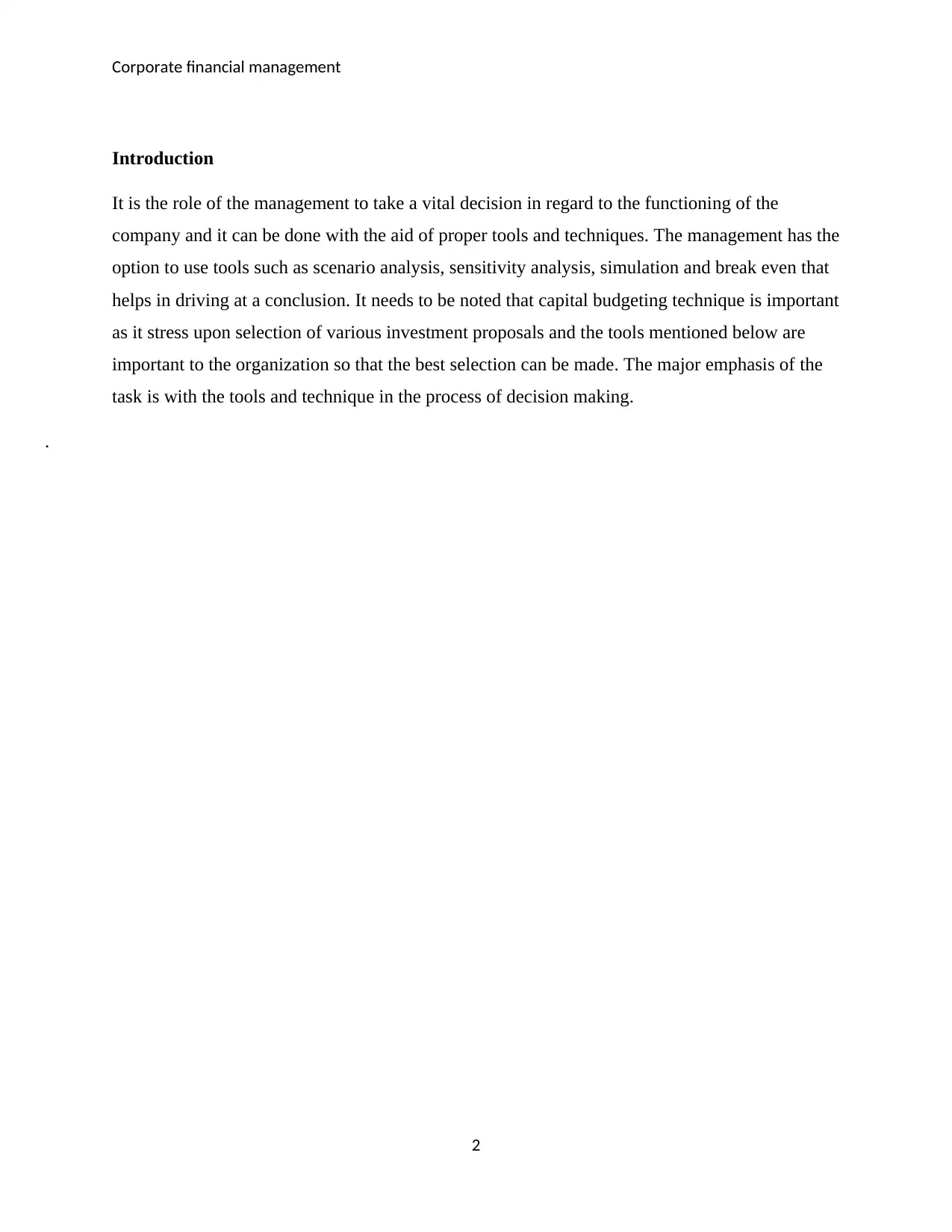
Corporate financial management
Introduction
It is the role of the management to take a vital decision in regard to the functioning of the
company and it can be done with the aid of proper tools and techniques. The management has the
option to use tools such as scenario analysis, sensitivity analysis, simulation and break even that
helps in driving at a conclusion. It needs to be noted that capital budgeting technique is important
as it stress upon selection of various investment proposals and the tools mentioned below are
important to the organization so that the best selection can be made. The major emphasis of the
task is with the tools and technique in the process of decision making.
.
2
Introduction
It is the role of the management to take a vital decision in regard to the functioning of the
company and it can be done with the aid of proper tools and techniques. The management has the
option to use tools such as scenario analysis, sensitivity analysis, simulation and break even that
helps in driving at a conclusion. It needs to be noted that capital budgeting technique is important
as it stress upon selection of various investment proposals and the tools mentioned below are
important to the organization so that the best selection can be made. The major emphasis of the
task is with the tools and technique in the process of decision making.
.
2

Corporate financial management
Sensitivity Analysis method can be interpreted as the statistical method, useful in analyzing the
consequential alterations from the expected assessment of the value. The capital budgeting can
be analyzed by studying in the current study. Sensitivity analysis is about determining and
assessing the value by which one can revamp the information input to derive the result in a
linear-programming method to continue unaltered equivalently (Correia et. al, 2005). The
process is helpful in justifying sensitivity in the information provided and used in calculating the
much-needed levels at every input to support the authorities in the decision-making process by
providing much-needed recommendations and simultaneously constructive in finally examine
the intensity of information acknowledged.
1. Sensitivity analysis and application in the capital budgeting process.
Sensitivity analysis concept assists in identifying the aspects of divergent values of independent
variables upon the dependent variables under various conditions. Apart from that, capital
budgeting method is a process to figure out a project to decide on to the project to be carried out
or leave. While analyzing an individual project, only financial aspect is considered by the
management of a company in the capital budgeting process, whereas in case of sensitivity
analysis method both financial and non-financial aspects are simultaneously taken into
consideration by the management of the organization (Kan & Zhang, 1999). That is why
management of an organization prefers sensitivity analysis concept over capital budgeting
system while evaluating the financial strength of a project under consideration (Brigham &
Ehrhardt, 2011). It can be said that management of the company determines and get the sense of
the success chances of a project by examining the project through sensitivity analysis system.
3
Sensitivity Analysis method can be interpreted as the statistical method, useful in analyzing the
consequential alterations from the expected assessment of the value. The capital budgeting can
be analyzed by studying in the current study. Sensitivity analysis is about determining and
assessing the value by which one can revamp the information input to derive the result in a
linear-programming method to continue unaltered equivalently (Correia et. al, 2005). The
process is helpful in justifying sensitivity in the information provided and used in calculating the
much-needed levels at every input to support the authorities in the decision-making process by
providing much-needed recommendations and simultaneously constructive in finally examine
the intensity of information acknowledged.
1. Sensitivity analysis and application in the capital budgeting process.
Sensitivity analysis concept assists in identifying the aspects of divergent values of independent
variables upon the dependent variables under various conditions. Apart from that, capital
budgeting method is a process to figure out a project to decide on to the project to be carried out
or leave. While analyzing an individual project, only financial aspect is considered by the
management of a company in the capital budgeting process, whereas in case of sensitivity
analysis method both financial and non-financial aspects are simultaneously taken into
consideration by the management of the organization (Kan & Zhang, 1999). That is why
management of an organization prefers sensitivity analysis concept over capital budgeting
system while evaluating the financial strength of a project under consideration (Brigham &
Ehrhardt, 2011). It can be said that management of the company determines and get the sense of
the success chances of a project by examining the project through sensitivity analysis system.
3
⊘ This is a preview!⊘
Do you want full access?
Subscribe today to unlock all pages.

Trusted by 1+ million students worldwide
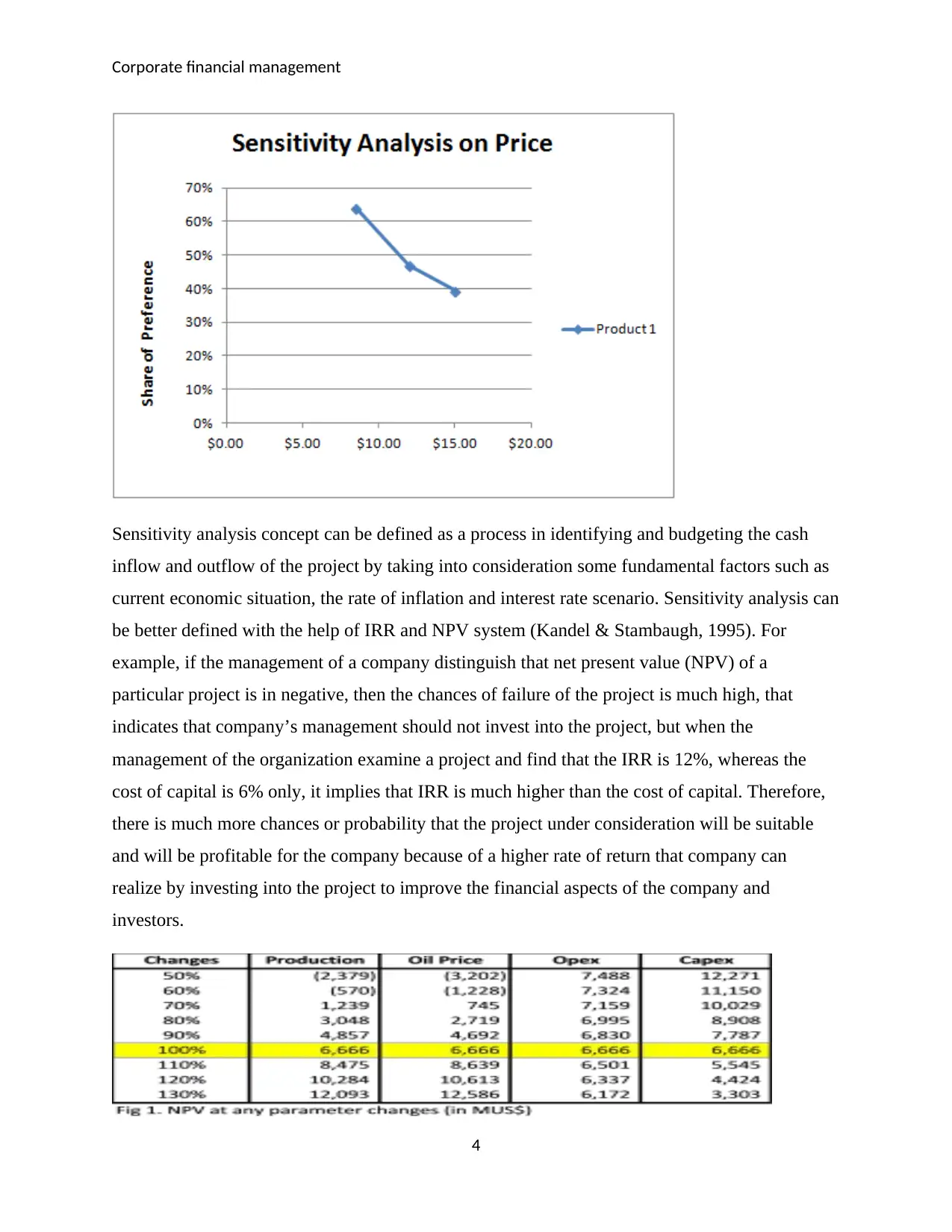
Corporate financial management
Sensitivity analysis concept can be defined as a process in identifying and budgeting the cash
inflow and outflow of the project by taking into consideration some fundamental factors such as
current economic situation, the rate of inflation and interest rate scenario. Sensitivity analysis can
be better defined with the help of IRR and NPV system (Kandel & Stambaugh, 1995). For
example, if the management of a company distinguish that net present value (NPV) of a
particular project is in negative, then the chances of failure of the project is much high, that
indicates that company’s management should not invest into the project, but when the
management of the organization examine a project and find that the IRR is 12%, whereas the
cost of capital is 6% only, it implies that IRR is much higher than the cost of capital. Therefore,
there is much more chances or probability that the project under consideration will be suitable
and will be profitable for the company because of a higher rate of return that company can
realize by investing into the project to improve the financial aspects of the company and
investors.
4
Sensitivity analysis concept can be defined as a process in identifying and budgeting the cash
inflow and outflow of the project by taking into consideration some fundamental factors such as
current economic situation, the rate of inflation and interest rate scenario. Sensitivity analysis can
be better defined with the help of IRR and NPV system (Kandel & Stambaugh, 1995). For
example, if the management of a company distinguish that net present value (NPV) of a
particular project is in negative, then the chances of failure of the project is much high, that
indicates that company’s management should not invest into the project, but when the
management of the organization examine a project and find that the IRR is 12%, whereas the
cost of capital is 6% only, it implies that IRR is much higher than the cost of capital. Therefore,
there is much more chances or probability that the project under consideration will be suitable
and will be profitable for the company because of a higher rate of return that company can
realize by investing into the project to improve the financial aspects of the company and
investors.
4
Paraphrase This Document
Need a fresh take? Get an instant paraphrase of this document with our AI Paraphraser
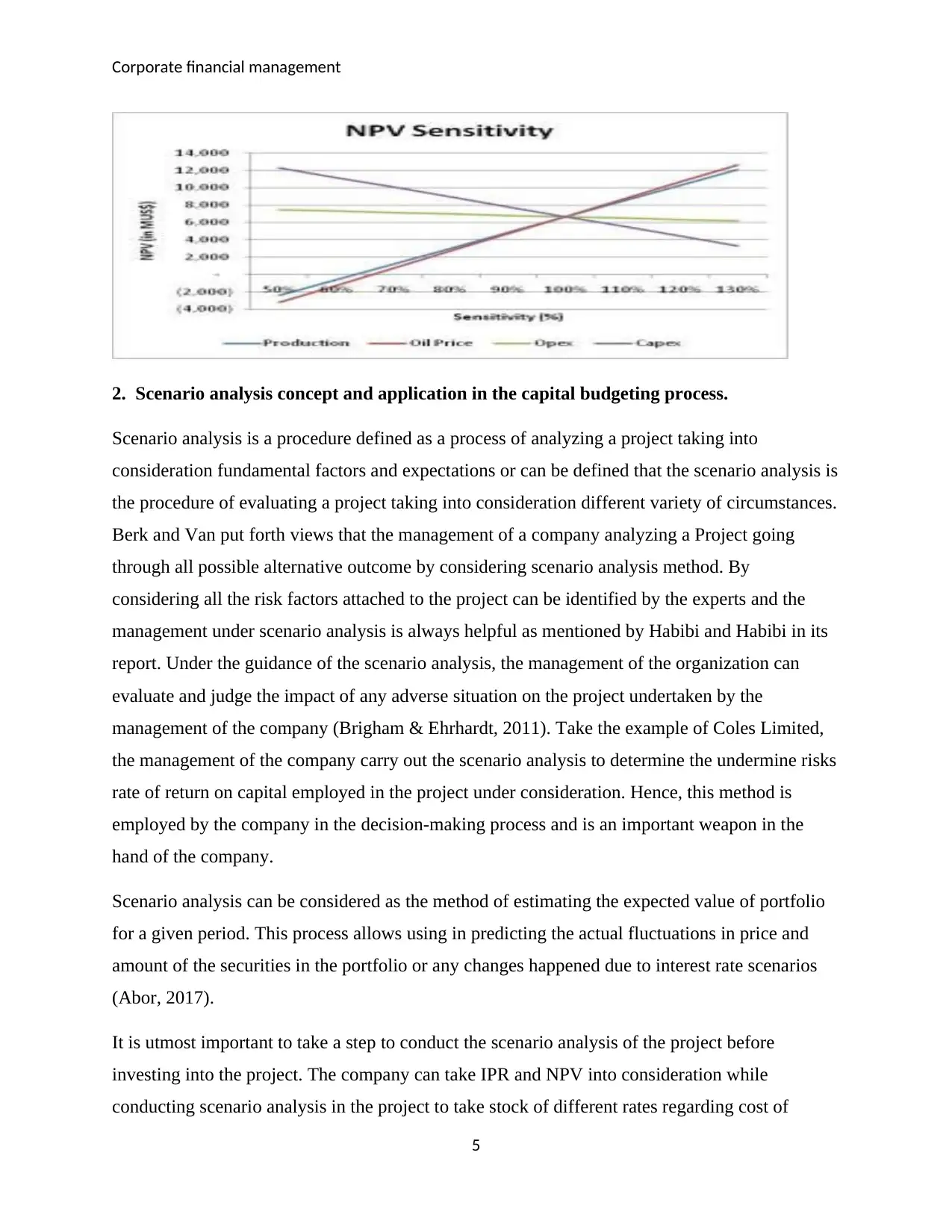
Corporate financial management
2. Scenario analysis concept and application in the capital budgeting process.
Scenario analysis is a procedure defined as a process of analyzing a project taking into
consideration fundamental factors and expectations or can be defined that the scenario analysis is
the procedure of evaluating a project taking into consideration different variety of circumstances.
Berk and Van put forth views that the management of a company analyzing a Project going
through all possible alternative outcome by considering scenario analysis method. By
considering all the risk factors attached to the project can be identified by the experts and the
management under scenario analysis is always helpful as mentioned by Habibi and Habibi in its
report. Under the guidance of the scenario analysis, the management of the organization can
evaluate and judge the impact of any adverse situation on the project undertaken by the
management of the company (Brigham & Ehrhardt, 2011). Take the example of Coles Limited,
the management of the company carry out the scenario analysis to determine the undermine risks
rate of return on capital employed in the project under consideration. Hence, this method is
employed by the company in the decision-making process and is an important weapon in the
hand of the company.
Scenario analysis can be considered as the method of estimating the expected value of portfolio
for a given period. This process allows using in predicting the actual fluctuations in price and
amount of the securities in the portfolio or any changes happened due to interest rate scenarios
(Abor, 2017).
It is utmost important to take a step to conduct the scenario analysis of the project before
investing into the project. The company can take IPR and NPV into consideration while
conducting scenario analysis in the project to take stock of different rates regarding cost of
5
2. Scenario analysis concept and application in the capital budgeting process.
Scenario analysis is a procedure defined as a process of analyzing a project taking into
consideration fundamental factors and expectations or can be defined that the scenario analysis is
the procedure of evaluating a project taking into consideration different variety of circumstances.
Berk and Van put forth views that the management of a company analyzing a Project going
through all possible alternative outcome by considering scenario analysis method. By
considering all the risk factors attached to the project can be identified by the experts and the
management under scenario analysis is always helpful as mentioned by Habibi and Habibi in its
report. Under the guidance of the scenario analysis, the management of the organization can
evaluate and judge the impact of any adverse situation on the project undertaken by the
management of the company (Brigham & Ehrhardt, 2011). Take the example of Coles Limited,
the management of the company carry out the scenario analysis to determine the undermine risks
rate of return on capital employed in the project under consideration. Hence, this method is
employed by the company in the decision-making process and is an important weapon in the
hand of the company.
Scenario analysis can be considered as the method of estimating the expected value of portfolio
for a given period. This process allows using in predicting the actual fluctuations in price and
amount of the securities in the portfolio or any changes happened due to interest rate scenarios
(Abor, 2017).
It is utmost important to take a step to conduct the scenario analysis of the project before
investing into the project. The company can take IPR and NPV into consideration while
conducting scenario analysis in the project to take stock of different rates regarding cost of
5

Corporate financial management
capital involved, simultaneously the officers involved in the process of conducting scenario
analysis can also determine the IPR and NPV during the period of high inflation scenario and
determine the cost of capital in the situation of depression in the economic situation in the market
(Abor, 2017).
6
capital involved, simultaneously the officers involved in the process of conducting scenario
analysis can also determine the IPR and NPV during the period of high inflation scenario and
determine the cost of capital in the situation of depression in the economic situation in the market
(Abor, 2017).
6
⊘ This is a preview!⊘
Do you want full access?
Subscribe today to unlock all pages.

Trusted by 1+ million students worldwide
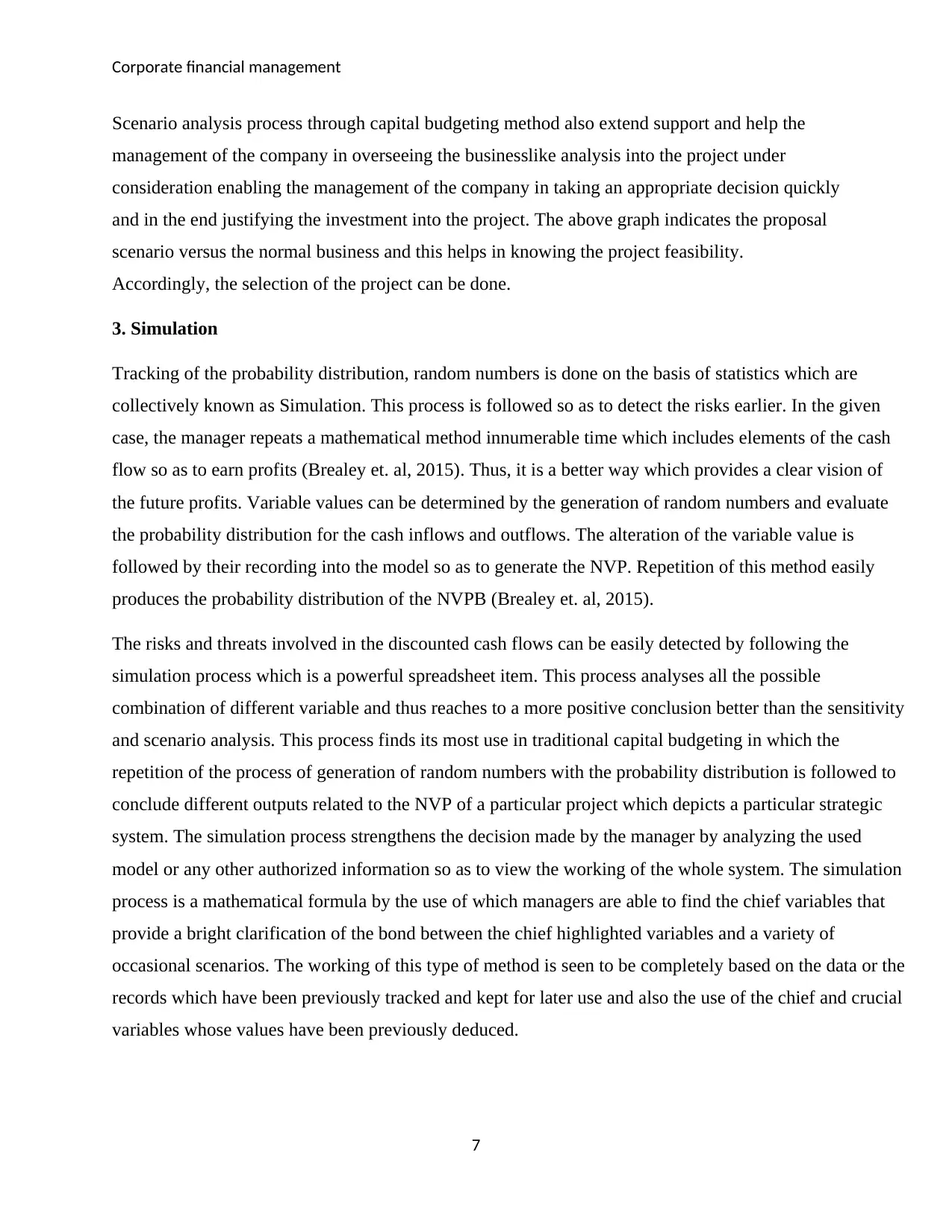
Corporate financial management
Scenario analysis process through capital budgeting method also extend support and help the
management of the company in overseeing the businesslike analysis into the project under
consideration enabling the management of the company in taking an appropriate decision quickly
and in the end justifying the investment into the project. The above graph indicates the proposal
scenario versus the normal business and this helps in knowing the project feasibility.
Accordingly, the selection of the project can be done.
3. Simulation
Tracking of the probability distribution, random numbers is done on the basis of statistics which are
collectively known as Simulation. This process is followed so as to detect the risks earlier. In the given
case, the manager repeats a mathematical method innumerable time which includes elements of the cash
flow so as to earn profits (Brealey et. al, 2015). Thus, it is a better way which provides a clear vision of
the future profits. Variable values can be determined by the generation of random numbers and evaluate
the probability distribution for the cash inflows and outflows. The alteration of the variable value is
followed by their recording into the model so as to generate the NVP. Repetition of this method easily
produces the probability distribution of the NVPB (Brealey et. al, 2015).
The risks and threats involved in the discounted cash flows can be easily detected by following the
simulation process which is a powerful spreadsheet item. This process analyses all the possible
combination of different variable and thus reaches to a more positive conclusion better than the sensitivity
and scenario analysis. This process finds its most use in traditional capital budgeting in which the
repetition of the process of generation of random numbers with the probability distribution is followed to
conclude different outputs related to the NVP of a particular project which depicts a particular strategic
system. The simulation process strengthens the decision made by the manager by analyzing the used
model or any other authorized information so as to view the working of the whole system. The simulation
process is a mathematical formula by the use of which managers are able to find the chief variables that
provide a bright clarification of the bond between the chief highlighted variables and a variety of
occasional scenarios. The working of this type of method is seen to be completely based on the data or the
records which have been previously tracked and kept for later use and also the use of the chief and crucial
variables whose values have been previously deduced.
7
Scenario analysis process through capital budgeting method also extend support and help the
management of the company in overseeing the businesslike analysis into the project under
consideration enabling the management of the company in taking an appropriate decision quickly
and in the end justifying the investment into the project. The above graph indicates the proposal
scenario versus the normal business and this helps in knowing the project feasibility.
Accordingly, the selection of the project can be done.
3. Simulation
Tracking of the probability distribution, random numbers is done on the basis of statistics which are
collectively known as Simulation. This process is followed so as to detect the risks earlier. In the given
case, the manager repeats a mathematical method innumerable time which includes elements of the cash
flow so as to earn profits (Brealey et. al, 2015). Thus, it is a better way which provides a clear vision of
the future profits. Variable values can be determined by the generation of random numbers and evaluate
the probability distribution for the cash inflows and outflows. The alteration of the variable value is
followed by their recording into the model so as to generate the NVP. Repetition of this method easily
produces the probability distribution of the NVPB (Brealey et. al, 2015).
The risks and threats involved in the discounted cash flows can be easily detected by following the
simulation process which is a powerful spreadsheet item. This process analyses all the possible
combination of different variable and thus reaches to a more positive conclusion better than the sensitivity
and scenario analysis. This process finds its most use in traditional capital budgeting in which the
repetition of the process of generation of random numbers with the probability distribution is followed to
conclude different outputs related to the NVP of a particular project which depicts a particular strategic
system. The simulation process strengthens the decision made by the manager by analyzing the used
model or any other authorized information so as to view the working of the whole system. The simulation
process is a mathematical formula by the use of which managers are able to find the chief variables that
provide a bright clarification of the bond between the chief highlighted variables and a variety of
occasional scenarios. The working of this type of method is seen to be completely based on the data or the
records which have been previously tracked and kept for later use and also the use of the chief and crucial
variables whose values have been previously deduced.
7
Paraphrase This Document
Need a fresh take? Get an instant paraphrase of this document with our AI Paraphraser

Corporate financial management
The main function of this process is to positively affect the decisions made by the manager with evidence
(Da et. al, 2012). Evidence about the threats prevailing in the project like risk return trade off are marked
in attention to the manager while the vague estimates are tried to be eliminated. Thus, the process of
simulation provides the manager to take a more practical and real decision so as to decide the profitability
of the undertaken project.
4. Break even analysis
Cost accounting and capital budgeting are the two sectors which mark the use of break even analysis so as
to calculate the profit earnings estimates and the quantity of stock in a undertaken particular project or
production line. This type of analysis is used to set a “breakeven point” which is generally referred to as a
state when the company has no net income. This means that the cost of the company is aligned with its
revenue. The revenue matches the cost and hence, is an important update for the management of the
future course of activities (Vaitilingam, 2010). But this analysis is far more useful than just this simple
definition. A thorough use of this analysis can enable one to gain information about certain variables and
behavior of some costs. The nature of various cost can be known with ease with the help of this technique.
This mentioned analysis helps the owner of the company to separate the costs in variable and fixed sectors
through deep study and detection.
The basic formula for break-even analysis is as follows:
BEQ = Fixed cost/ (P-VC)
8
The main function of this process is to positively affect the decisions made by the manager with evidence
(Da et. al, 2012). Evidence about the threats prevailing in the project like risk return trade off are marked
in attention to the manager while the vague estimates are tried to be eliminated. Thus, the process of
simulation provides the manager to take a more practical and real decision so as to decide the profitability
of the undertaken project.
4. Break even analysis
Cost accounting and capital budgeting are the two sectors which mark the use of break even analysis so as
to calculate the profit earnings estimates and the quantity of stock in a undertaken particular project or
production line. This type of analysis is used to set a “breakeven point” which is generally referred to as a
state when the company has no net income. This means that the cost of the company is aligned with its
revenue. The revenue matches the cost and hence, is an important update for the management of the
future course of activities (Vaitilingam, 2010). But this analysis is far more useful than just this simple
definition. A thorough use of this analysis can enable one to gain information about certain variables and
behavior of some costs. The nature of various cost can be known with ease with the help of this technique.
This mentioned analysis helps the owner of the company to separate the costs in variable and fixed sectors
through deep study and detection.
The basic formula for break-even analysis is as follows:
BEQ = Fixed cost/ (P-VC)
8
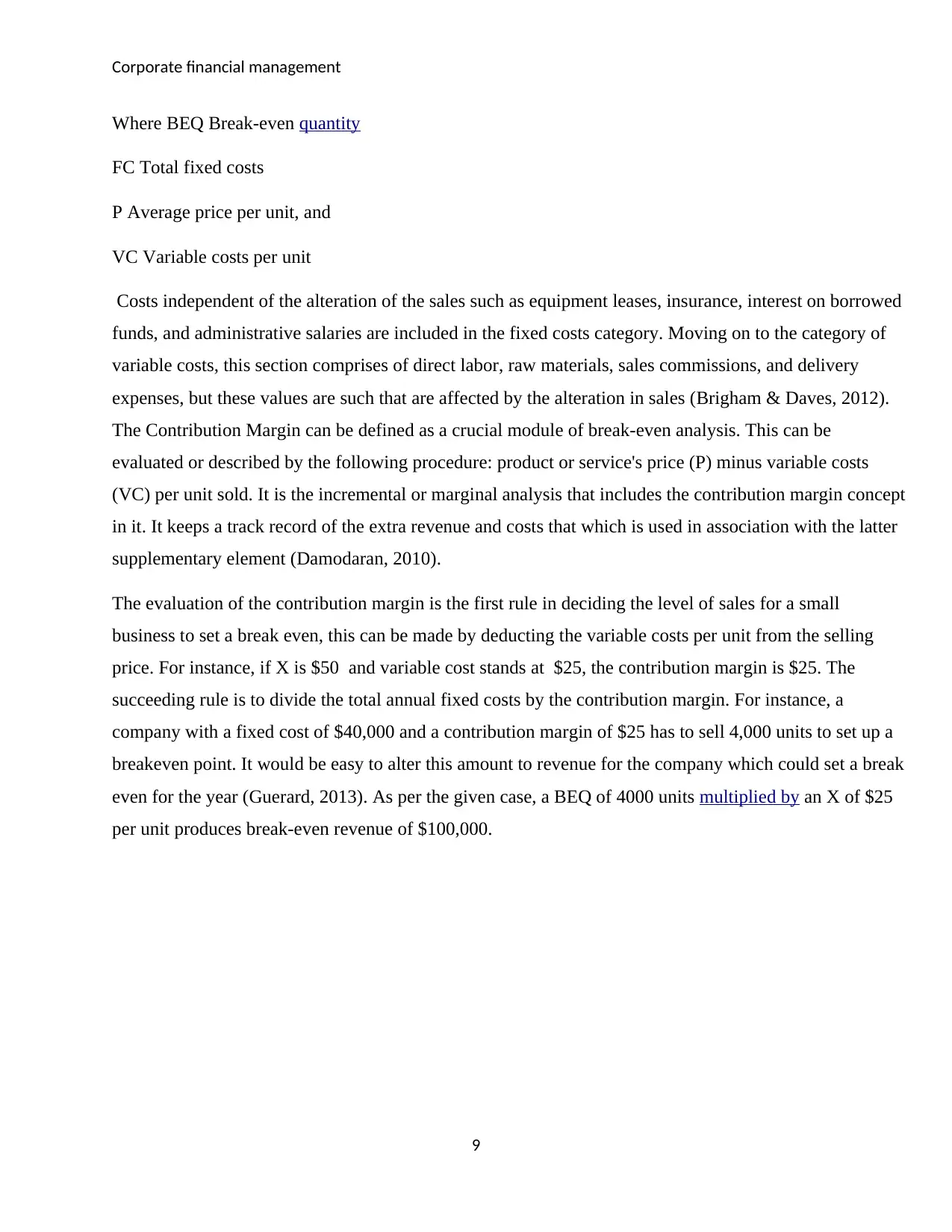
Corporate financial management
Where BEQ Break-even quantity
FC Total fixed costs
P Average price per unit, and
VC Variable costs per unit
Costs independent of the alteration of the sales such as equipment leases, insurance, interest on borrowed
funds, and administrative salaries are included in the fixed costs category. Moving on to the category of
variable costs, this section comprises of direct labor, raw materials, sales commissions, and delivery
expenses, but these values are such that are affected by the alteration in sales (Brigham & Daves, 2012).
The Contribution Margin can be defined as a crucial module of break-even analysis. This can be
evaluated or described by the following procedure: product or service's price (P) minus variable costs
(VC) per unit sold. It is the incremental or marginal analysis that includes the contribution margin concept
in it. It keeps a track record of the extra revenue and costs that which is used in association with the latter
supplementary element (Damodaran, 2010).
The evaluation of the contribution margin is the first rule in deciding the level of sales for a small
business to set a break even, this can be made by deducting the variable costs per unit from the selling
price. For instance, if X is $50 and variable cost stands at $25, the contribution margin is $25. The
succeeding rule is to divide the total annual fixed costs by the contribution margin. For instance, a
company with a fixed cost of $40,000 and a contribution margin of $25 has to sell 4,000 units to set up a
breakeven point. It would be easy to alter this amount to revenue for the company which could set a break
even for the year (Guerard, 2013). As per the given case, a BEQ of 4000 units multiplied by an X of $25
per unit produces break-even revenue of $100,000.
9
Where BEQ Break-even quantity
FC Total fixed costs
P Average price per unit, and
VC Variable costs per unit
Costs independent of the alteration of the sales such as equipment leases, insurance, interest on borrowed
funds, and administrative salaries are included in the fixed costs category. Moving on to the category of
variable costs, this section comprises of direct labor, raw materials, sales commissions, and delivery
expenses, but these values are such that are affected by the alteration in sales (Brigham & Daves, 2012).
The Contribution Margin can be defined as a crucial module of break-even analysis. This can be
evaluated or described by the following procedure: product or service's price (P) minus variable costs
(VC) per unit sold. It is the incremental or marginal analysis that includes the contribution margin concept
in it. It keeps a track record of the extra revenue and costs that which is used in association with the latter
supplementary element (Damodaran, 2010).
The evaluation of the contribution margin is the first rule in deciding the level of sales for a small
business to set a break even, this can be made by deducting the variable costs per unit from the selling
price. For instance, if X is $50 and variable cost stands at $25, the contribution margin is $25. The
succeeding rule is to divide the total annual fixed costs by the contribution margin. For instance, a
company with a fixed cost of $40,000 and a contribution margin of $25 has to sell 4,000 units to set up a
breakeven point. It would be easy to alter this amount to revenue for the company which could set a break
even for the year (Guerard, 2013). As per the given case, a BEQ of 4000 units multiplied by an X of $25
per unit produces break-even revenue of $100,000.
9
⊘ This is a preview!⊘
Do you want full access?
Subscribe today to unlock all pages.

Trusted by 1+ million students worldwide

Corporate financial management
It provides the manager to separate the costs into fixed and variable categories. Capital budgeting aligned
with break even analysis can put up estimates of the profit making probability of the undertaken project. It
provides a vision of the future survival of the project and whether to invest in such a project or not (Ferris
et. al, 2010).
Fixed Costs Variable Costs
Labor 3000 Flour 0.3
Rent 3000 Mustard 0.04
insurance 900 Water 0.03
Promotions 600 Butter 3
Fees 500 Cheese 0.5
Total 8000 Total 3.87
10
It provides the manager to separate the costs into fixed and variable categories. Capital budgeting aligned
with break even analysis can put up estimates of the profit making probability of the undertaken project. It
provides a vision of the future survival of the project and whether to invest in such a project or not (Ferris
et. al, 2010).
Fixed Costs Variable Costs
Labor 3000 Flour 0.3
Rent 3000 Mustard 0.04
insurance 900 Water 0.03
Promotions 600 Butter 3
Fees 500 Cheese 0.5
Total 8000 Total 3.87
10
Paraphrase This Document
Need a fresh take? Get an instant paraphrase of this document with our AI Paraphraser
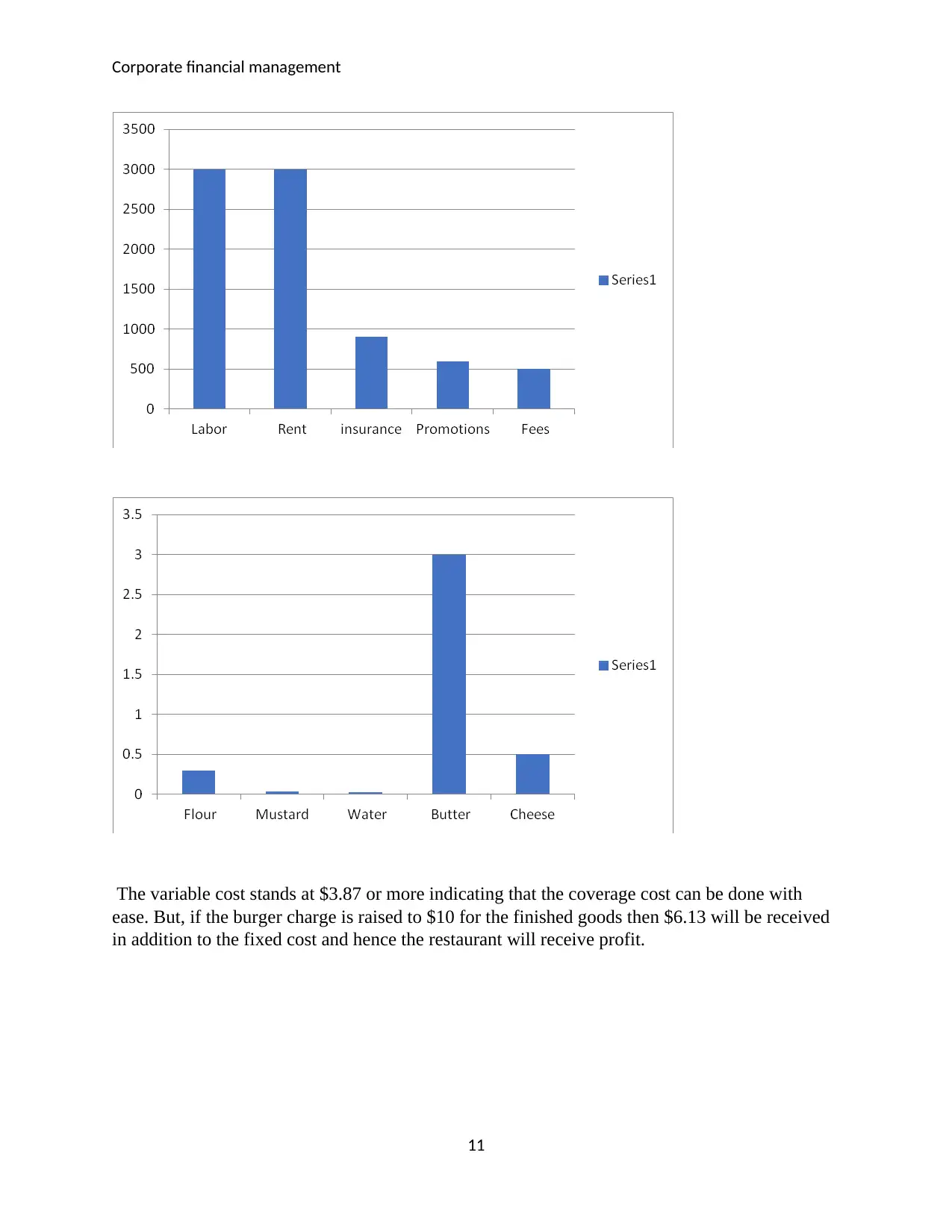
Corporate financial management
The variable cost stands at $3.87 or more indicating that the coverage cost can be done with
ease. But, if the burger charge is raised to $10 for the finished goods then $6.13 will be received
in addition to the fixed cost and hence the restaurant will receive profit.
11
The variable cost stands at $3.87 or more indicating that the coverage cost can be done with
ease. But, if the burger charge is raised to $10 for the finished goods then $6.13 will be received
in addition to the fixed cost and hence the restaurant will receive profit.
11
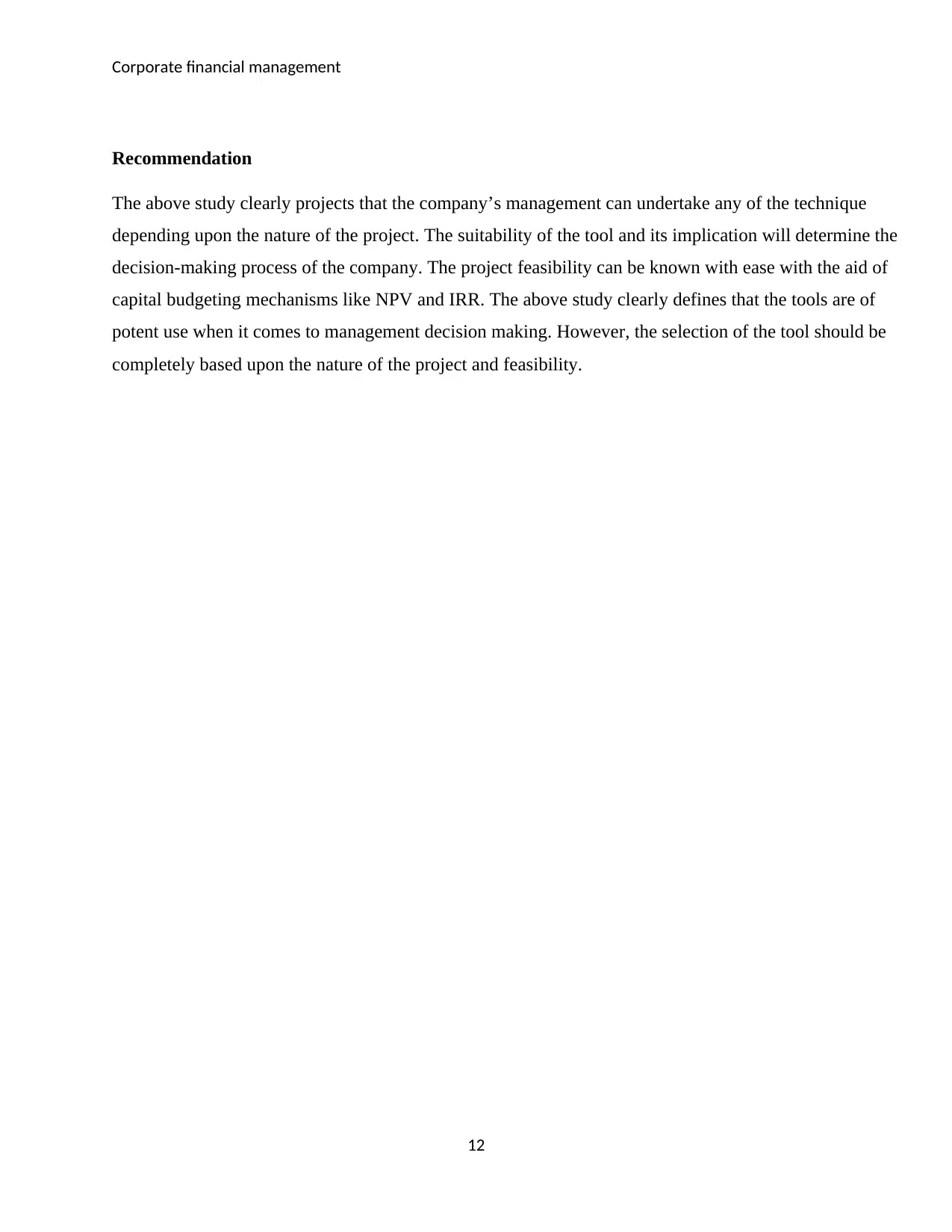
Corporate financial management
Recommendation
The above study clearly projects that the company’s management can undertake any of the technique
depending upon the nature of the project. The suitability of the tool and its implication will determine the
decision-making process of the company. The project feasibility can be known with ease with the aid of
capital budgeting mechanisms like NPV and IRR. The above study clearly defines that the tools are of
potent use when it comes to management decision making. However, the selection of the tool should be
completely based upon the nature of the project and feasibility.
12
Recommendation
The above study clearly projects that the company’s management can undertake any of the technique
depending upon the nature of the project. The suitability of the tool and its implication will determine the
decision-making process of the company. The project feasibility can be known with ease with the aid of
capital budgeting mechanisms like NPV and IRR. The above study clearly defines that the tools are of
potent use when it comes to management decision making. However, the selection of the tool should be
completely based upon the nature of the project and feasibility.
12
⊘ This is a preview!⊘
Do you want full access?
Subscribe today to unlock all pages.

Trusted by 1+ million students worldwide
1 out of 13
Related Documents
Your All-in-One AI-Powered Toolkit for Academic Success.
+13062052269
info@desklib.com
Available 24*7 on WhatsApp / Email
![[object Object]](/_next/static/media/star-bottom.7253800d.svg)
Unlock your academic potential
Copyright © 2020–2025 A2Z Services. All Rights Reserved. Developed and managed by ZUCOL.





